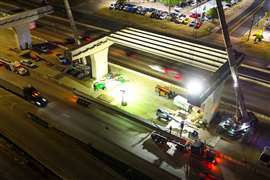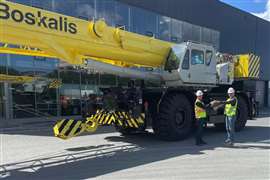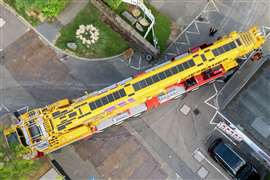Tried & true
24 April 2008

In the 1970s, Bill Stramer hired on at FMC Link-Belt in Iowa as draftsman in the engineering department. A bright and affable young man, he was adept in his job, but his bosses soon realized the company would be much better served with the sharp and quick-witted Stramer in their sales training program. Here was a young man who understood every aspect of a crane's design, its mechanics and capacities, plus, he was a people person.
For more than 30 years Stramer has been working his way up the corporate ladder at Link-Belt. In the early 1980s he graduated from the company's highly heralded and intensely strategic sales and marketing training program, and was assigned to take over a sales territory in the Denver area and do what he loves to do: sell cranes.
“Being a district sales manager was a great job, a really great job,” says Stramer of the eight years he spent “in the field.”
But in time the management team would realize they needed Stramer back at the headquarters office to take on more responsibility. Several times during his tenure the market for cranes would wane, and like its competitors, Link-Belt would have to trim expenses and lay-off employees. But Stramer weathered those economic downturns, becoming a key player in helping Link-Belt strategize how to “stomach the bad cycles and plan for the up cycles,” he says.
As vice president of sales and marketing at Link-Belt, Stramer heads a group that he says purposefully “flies under the radar,” while at the same time grows market share and positions its cranes as market leaders.
Last month, ACT sat down with Stramer to talk about his career in the industry and to discuss market implications, new products, distribution and what it takes to stay competitive.
You have been with Link-Belt your entire professional career, which is pretty rare in today's business environment. What led to your longevity with the company?
I think my career has been similar to others in the crane industry in that I've held positions in different disciplines within our industry like engineering, product service, sales and marketing. The thing that's unusual about me is that all of these “different jobs” have been with the same company. For me, the attraction to Link Belt has been the opportunity to work with good people in an environment that promotes career development.
Having been with Link-Belt so long, you must have a kinship with the product and its distributors. What do you think distinguishes Link-Belt cranes? Link-Belt people?
Our people communicate utilizing both our mouths and our ears. I believe that this is the key thing that sets us apart from our competition and has helped us evolve our business and products to the level that they are today. Having been with one company for over 30 years, I most certainly have developed many long-term relationships with both dealers and customers. Basically, I've grown up in the business with a lot of them.
One of the benefits that we at Link-Belt enjoy, and that sets us apart, is our corporate structure. We are a division of Sumitomo Heavy Industries, a six billion dollar a year corporation that expects us to manage and plan our business for the long term. We are not under the spotlight and pressure of quarterly performance that some of our publicly traded competitors are. Our day-to-day decisions are based on long-term objectives, and it shows.
What is “lean manufacturing,” as it relates to the Link-Belt product, the Link-Belt strategy?
In 1994 Link-Belt embarked on a total quality program that focuses on continuous improvement. Our lean manufacturing production system is modeled after Toyota's lean production system that is part of the advanced course curriculum at the University of Kentucky's Center for Robotics and Industry.
As we continue to evolve this program, the fundamental structure of our lean manufacturing is the elimination of waste. We adhere to the operating principles of QCD - quality, cost, delivery - in every aspect of all processes.
For us, lean manufacturing enables us to deliver quality products on time, and by eliminating waste in the process, allows us to provide better value to our customers. It has worked very well for us. You can actually see it working in our plant.
In terms of product development, where is Link-Belt in regards to crawler, AT, RT and truck crane development?
One of our strengths, as a result of listening and responding to customer needs, is that we have developed some innovative new products over the years. The RTC-80100 is one that comes to mind recently, and the HTC-8690 introduced last year. We are proud of this tradition and as a result tend to be secretive when it comes to our product development. Currently we have in development new products in all product segments.
What is the timetable for these new machines? Can you talk about specifics?
Generally, we have utilized ConExpo to introduce new products. With our accelerated developmental process, we have several new machines, which we will be introducing in October 2006 at our Cranefest event where we host a large group of customers, distributors and press.
What is your opinion of the market for crawler cranes in the US and has it recovered?
The overall North American crawler crane market has begun to recover. The recovery started in the smaller tonnage classes and moved to the larger classes as we moved through 2005.
Our crawler crane business showed solid growth in 2005. One of the contributing factors to our strong performance in 2005 was the introduction of our new 110 ton crawler, the 218 HSL. The ability of this machine to move with the side-frames installed and still be under 100,000 pounds, is one of its unique features.
We expect that 2006 will bring increased demand driven by the transportation and energy bills, hurricane clean-up and refinery work. The ability of manufacturers to produce products will be one of the limiting factors as to the total amount of market growth. This lack of availability of product will be most prevalent in the larger tonnage classes. It wasn't that long ago that a large population of 200-plus ton machines was available in under-utilized rental fleets, but today, all of those machines are busy and the pressure is on the manufacturers to meet the demands.
Do you envision Link-Belt producing a telescopic crawler (like the Liebherr LTR 1100 or the new Bendini?)
We will introduce a new telescopic crawler crane this fall.
Has the Manitowoc/Kobelco crawler crane agreement impacted Link-Belt sales? Do you envision more of these sorts of partnerships in the future?
This type of supply agreement will have some impact on all market participants. Considering that the scope of this specific agreement is focused on the 150 ton and below crawler market means that it had less of an impact on us than it's having on other competitors. This market segment is a particular stronghold for Link-Belt, and we have actually grown market share in the time since this agreement has been in place.
I expect that there may be additional new arrangements between suppliers. Although supply agreements have their negative aspects, they do provide the ability for a manufacturer to enter a market quickly and without the product development expense of a self-designed product. As early as 1962, we entered into a supply/license agreement with Sumitomo Heavy Industries. Since that time, we have evolved into our current structure where we work closely with our sister company, Hitachi Sumitomo Construction Crane Company. Combined today, we are the world's leading supplier of crawler cranes.
Do you foresee Link-Belt expanding its all terrain line, either with Tadano or independently? Do you think the AT will replace the truck crane in the market?
We will expand our all-terrain product line with a new machine that is scheduled for introduction this fall. For the record, our supply agreement with Tadano Faun began in early 2001. If you recall, 2001 through 2003 was a difficult all terrain market in North America and proved to be a challenge as we entered this new arena. Adding to our difficulty was the fact that we offered only one model for our distribution to market. In the time since our relationship started, we have worked together with Tadano Faun to develop new models that are competitive and take into account the requirements of the North American crane user.
At ConExpo in 2005 we introduced new 130 and 200 ton machines that have performed well and are building our reputation as an all terrain supplier. The combination of strong specification machines, sold and supported by our distributor network, will position us to be a serious participant in this market.
As to the question of whether all terrain cranes will replace truck cranes in North America, my answer is “no way.” The landscape of North America demands that over-the-road cranes travel extreme distances between jobs. Truck cranes provide a much more cost-effective combination of initial investment and long-term maintenance cost. As North American manufacturers have developed new truck cranes with reach and capacity specifications that are comparable to the all-terrain products, we have seen great success with the truck crane and a reduction in the all-terrain performance in those classes. A good example of this is the success of our HTC-8690 truck crane. Since introduction, we have received orders exceeding the 200 unit level.
A few years back, Link-Belt looked at getting into the boom truck business. Do you foresee a Link-Belt boom truck in the near future?
We did look at the boom truck business a few years back and we continue to have interest in the boom truck market.
Many of the oldest names in crane distribution are long-time Link-Belt dealers. How does Link-Belt approach distribution in today's frenetic marketplace?
Number one, we are committed to selling cranes through distribution. The overall superior product support that results from strong regional distribution cannot be matched by a manufacturer on a direct basis. I think a number of manufacturers are coming to realize that North America is a large expanse of land and, from a product support perspective, presents a huge challenge.
Over the last 15 years we have worked to develop our current family of 35-plus distributors, which represents a combination of regional and state-sized territories. Without a doubt, whether your measurement is product support capabilities or strength of balance sheets, our Link Belt crane distribution family is second to none in North America.
The real question may be “how do we attract good distribution and build strong, long-term relationships.” Our success starts with reasonable, mutually agreed upon performance targets. Add in a consistent, long-term management team that doesn't change the direction of the company on a weekly basis and you begin to see the secret to our success.
Do you think there is still such a thing as brand loyalty in terms of crane sales?
Absolutely, there is still brand loyalty in the crane business. Cranes are one of the few construction equipment product groups that still have brand loyalty. Brand loyalty is a combination of several factors. First is the ability of the product and the support mechanism to perform on the job. Next is the competitive advantage that the customer comes to expect from a manufacturer's products. And, finally, the continuity of the distributor and manufacturer's people that provides the comfort that issues that may arise will be looked after by a friendly face.
The vast majority of Link-Belt customers know their distributor management team on a first-name basis. The same can be said about our team. It may sound corny, but the crane customers know the “Link-Belt Guys” and enjoy doing business with us. There is something to be said about dealing with someone you know versus a new guy each time you're in the market for a machine.
Times are good right now in the crane business. Do you worry about a downturn?
We are always concerned about the next move in the market, up or down. Our management team has few levels and as a result of this flat organization, we are close to the market. We believe that this closeness to the market provides us with a better feel for market trends and allows us to be quicker to respond to market changes.
Looking back on your career, what stands out as highlights?
I'm proud of several accomplishments. From a company perspective, to have been a member of a team that helped to develop some of the most dominant crane products in North America over the last 15 years is a source of great pride. To have contributed to Link-Belt's move from “just another supplier” in the telescopic truck and crawler markets to the market leader in both segments is a real highlight.
On the personal side, I have enjoyed my involvement in SC&RA and the Crane Rental Association of Canada. I had the honor of being the first crane manufacturer's representative to chair the crane and rigging group in SC&RA and I currently sit on their board of directors. I was also involved from the very beginning with the development of SC&RA's crane operator certification program (NCCCO) and still hold the position of commissioner. With our Canadian friends, I was the first US citizen and first crane manufacturer's representative to sit on the board of directors of the Crane Rental Association of Canada.
What's your favorite thing to do when you are not running the sales operation at Link-Belt?
My wife and I have two teenage sons, and when I'm not at work, I am with my family. We enjoy any activity that includes water, boating, fishing, etc. In my teenage years, I was a “gear head” and it has apparently carried over to our kids. High horsepower motor sports, drag racing, stock cars, tractor and truck pulls are all a big draw for us.
STAY CONNECTED


Receive the information you need when you need it through our world-leading magazines, newsletters and daily briefings.
CONNECT WITH THE TEAM











